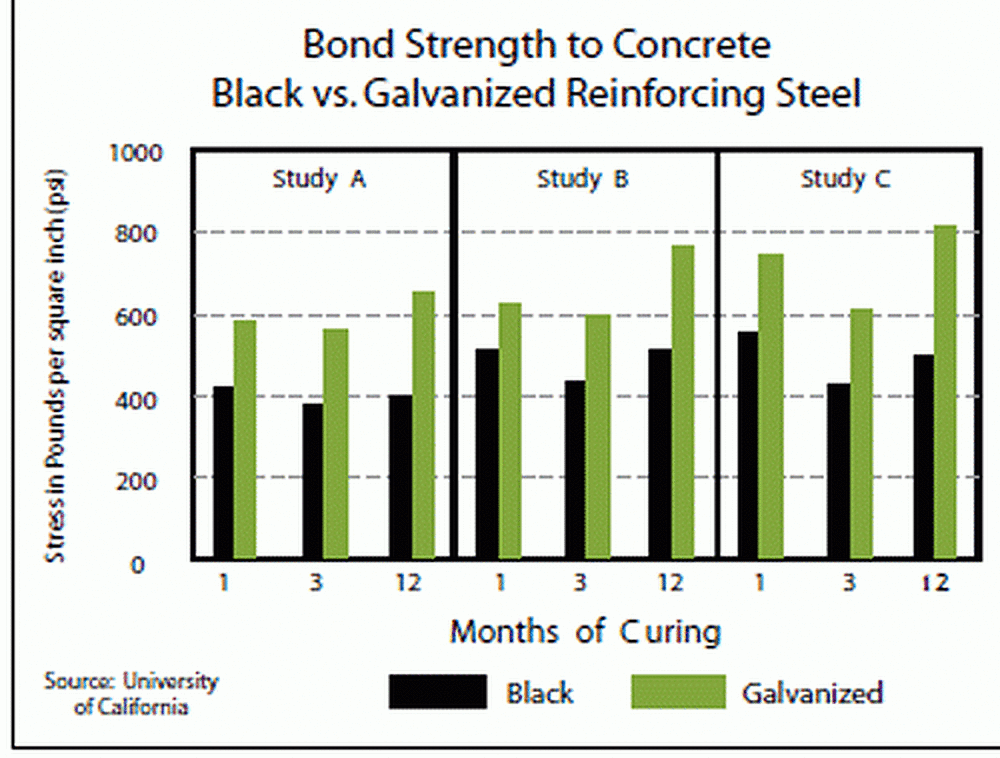Bond Strength of Galvanized Rebar
How does the bond strength of hot-dip galvanized rebar to concrete compare to black and epoxy-coated rebar?
The use of reinforced concrete relies on a good bond between the reinforcing bars and the concrete. Early tests on the bond strength of various rebar configurations reported confusing results. Galvanized rebar showed good bond strength in some tests and poor bond strength in others. More recent studies have all shown that galvanized rebar bond strength is equal or higher than black steel bond strength. It cannot be denied that the bright, uniform and smooth appearance of a well-galvanized surface gives one the impression of much poorer adhesion than that of bare steel mill scaled or rust on the surface. In this instance, however, as in many others, this impression does not agree with the recent experimental data.

Three studies looked at the bond strength of hot-dip galvanized rebar compared to black rebar: Zinc Coated Reinforcement for Concrete, The Influence of Steel Galvanization on Rebars Behavior in Concrete, and Bond of Ribbed Galvanized Reinforcing Steel in Concrete. In each of these studies, researchers found hot-dip galvanized rebar had the higher bond strength to concrete than black rebar. Figure 1 shows the various bond strengths observed for hot-dip galvanized rebar and black rebar in different studies. The increase in bond strength offered by the hot-dip galvanized coating is believed to be caused by calcium hydroxyzincate crystals, which develop between the galvanized coating and the concrete. The crystals increase the adhesion of the galvanized rebar to the concrete and thereby increase the bond strength.
At one time there was concern about possible hydrogen evolution when galvanized steel reacted with wet cement paste until the paste cured, which could be several hours or longer. If hydrogen developed between the concrete and the galvanized coating on the rebar, the bond strength of the system could decrease. Tests have shown this concern is less of an issue than previously thought for two reasons. First, hydrogen evolution may occur for a much shorter time than previously thought. Second, it is possible hydrogen evolution occurs not at the cement matrix-galvanized bar interface, but at the iron-zinc alloy layer, which means the hydrogen would not interfere with the bond strength at all.
ASTM A767/ A767M requires hot-dip galvanized rebar be dipped into a chromate quench after galvanizing to prevent possible hydrogen evolution as explained above. In addition to chromate quenches, some types of concrete mixes contain enough chromates to prevent hydrogen evolution between wet cement paste and hot-dip galvanized steel. Fusion bonded epoxy coatings are also commonly used to protect rebar from corrosion. Studies from the American Society of Civil Engineers, the International Journal of Cement Composites and Lightweight Concrete, and the Proceedings Institution of Civil Engineers, Structures and Buildings found epoxy-coated rebar had a reduction of 20% to 50% in bond strength to concrete when compared to black rebar. (In addition to traditional fusion-bonded epoxy rebar, the information obtained in these studies would apply to proprietary coatings as well, such as zinc-coated rebar that has been epoxy-coated since the epoxy-coating is still the outermost layer on the rebar and comes into contact with the concrete.) This means epoxy-coated rebar has a similar bond strength to that of plain round rebar, which is substantially less than that of deformed black rebar. When compared to the relative bond strength of hot-dip galvanized to black rebar in the other studies, this means hot-dip galvanized rebar has much higher bond strength than that of epoxy-coated rebar.
In summary, hot-dip galvanized rebar offers higher bond strength to concrete than black rebar or epoxy-coated rebar. This means the overlap length of bars can be designed to be the same length whether the bars are black or hot-dip galvanized. Most of the information in this article was referenced from the book, Galvanized Steel Reinforcement in Concrete. To obtain a copy of this book please contact the AGA Technical Department at 720-361-4485.
Learn more about galvanized rebar and earn continuing education credits by requesting an in-person seminaror taking our online rebar seminar.
© 2025 American Galvanizers Association. The material provided herein has been developed to provide accurate and authoritative information about after-fabrication hot-dip galvanized steel. This material provides general information only and is not intended as a substitute for competent professional examination and verification as to suitability and applicability. The information provided herein is not intended as a representation or warranty on the part of the AGA. Anyone making use of this information assumes all liability arising from such use.

